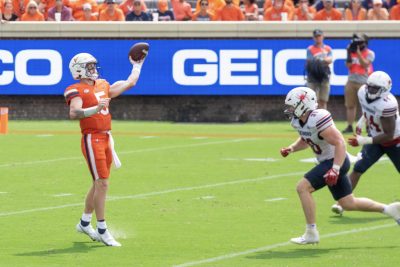UVA’s passing game mystery: Is it the QB, the receivers, the O-Line or the system?
By Jerry Ratcliffe

Virginia quarterback Brennan Armstrong throws a pass in the season opener against Richmond. (Photo by Michael Bruder)
While talking to some other ACC writers this week, it came to light that perhaps the biggest story in ACC football so far this season has been the disappearance of Virginia’s offense.
Other big stories have been the emergence of Carolina — tomorrow’s UVA opponent — under the phenomenal year freshman quarterback Drake Maye is having, and whether or not DJ Uiagalelei could lead Clemson back to the Promised Land. But for Virginia’s high-powered offense to fade into oblivion has been a mind-boggling blow to every Wahoo fan, and to ACC football observers.
Sure, it was a well-considered fact heading into the season that UVA’s offensive line was new and inexperienced. It was a given that a new coaching regime with a new system would take some adjustment. However, in the eighth week of the season, the Cavaliers went four quarters and four overtimes against Miami last week and couldn’t stick it in the end zone.
With Brennan Armstrong — who will likely become only the 15th player in ACC history to reach 10,000 career yards of total offense on Saturday — along with a star-studded fleet of experienced receivers, guys who were nearly unstoppable a year ago, going four quarters and four overtimes and not scoring seemed unfathomable.
Armstrong’s numbers, as has been documented here all season, are way off from last year. Was the transition in passing games to a more structured philosophy that Tony Elliott used at Clemson more challenging than he expected? What’s the deal?
“I was expecting that the throwing and catching would come a little bit easier and quicker than it has,” Elliott said this week. “At the same time, when the quarterback is learning a new progression system, and if he’s late with the ball, then now the ball placement is not where it needs to be with the receivers’ timing. They need to be where the quarterback is expecting them to be. So that’s something that I thought was going to happen a little bit quicker.”
Elliott said all of that change takes time, but Virginia is running out of time with four games left this season. The Cavaliers are 3-5 overall, 1-4 in the ACC, and underdogs to No. 17 North Carolina tomorrow afternoon.
If nothing else, tomorrow’s game could be a good barometer of where Armstrong stands. Last year against the Tar Heels, he obliterated UVA’s single-game passing record by throwing for a mind-boggling 554 yards in a 59-39 loss in Chapel Hill.
Not only has the transition to a new passing philosophy been rough-going, but his protection hasn’t been great either with the new offensive line.
According to PFF, Armstrong has been pressured in 40.4 percent of the snaps he has taken this year (compared to only 26.3 percent of the time a year ago). On those snaps this season, his completion rate is 46.3 percent, with 3 touchdowns, 7 interceptions and an unimpressive 48.3 NFL passer rating.
Last year, he completed 45.1 percent of those snaps under pressure for 3 TDs, no interceptions and a 78.3 rating.
A bigger difference is when he is not under pressure, which reveals that perhaps it’s not the offensive line giving him as many problems, but rather the system instead.
In passes where he hasn’t been pressured this season, Armstrong has a 59.1-percent completion percentage for 3 TDs, 2 interceptions and a 79.3 NFL passer rating.
In 2021, when Armstrong wasn’t under pressure, he had a 69.1 pass-completion percentage, 28 TD passes, 10 interceptions and a 111.0 NFL passer rating.
“The areas where Brennan still has to work, is trust your protection and go through your progressions, step up, deliver the ball,” Elliott said, “as opposed to looking to break the pocket too quickly.”
The coach pointed out one third-down situation against Miami when Armstrong’s No. 1 progression was coming open, but he didn’t trust it.
“Now, he needs to go to number two, Lavel’s (Davis) screaming wide open coming on the shallow route,” Elliott said. “We dump the ball off to him. He runs for a first down. So just those things of trusting your progression, trusting your protection to be able to deliver the ball.”
Elliott said that NFL quarterbacks Patrick Mahomes and Dak Prescott have drawn praise for their ability to throw “off-platform” passes, and college quarterbacks want to emulate those throws, even though Armstrong is pretty good at the off-platform throws.
Elliott blames part of the problem of the passing game on receivers dropping so many balls.
“We’ve got 40-plus drops, and then I think [Armstrong’s] been trying to throw the ball perfect, where he just needs to throw the ball where he’s supposed to throw it and trust that the receiver is going to make the catch,” the coach said. “So I think those are the three things that have impacted, and the protection, too.
“When you’re having to get the ball out before you’re ready, or you’re having to move in the pocket and reset, that messes with the timing and then balls are a little bit behind. But I think the biggest thing is, guy’s got to make the catch required for him no matter what. If the quarterback gets it close, catch the ball.”
Elliott said he believes his receivers have allowed some balls to get away just because they didn’t have the desperation to make the catches.
A few weeks ago, the coach wasn’t happy that when protection broke down, receivers weren’t adjusting their pass routes to help out their quarterback. Has that changed?
“Whenever you build an offensive system, you’re always going to have scramble rules in terms of, the quarterback breaks the pocket to my side, and I have — depending upon my depth and the route that I just finished running — these are my rules,” Elliott explained. “I think the guys were just becoming comfortable in general with what we’re asking them to do because it’s a combination of timing.
“So you’ve got step counts, you have yardages, you have different over-and-under rules. You’ve got different conversions from hitch routes, slant rules. So there’s things that they have to get accustomed to in general from a route-running perspective. Then when the play breaks down, they have to be on the same page as the quarterback.”
Again, the offensive line plays a big part in all of this and the inconsistency of protection in the passing game.
“We just don’t have the luxury of being consistent enough to give [Armstrong] time to just sit back there and go through three progressions,” Elliott said. “We’ve got to hit that first or second progression right now in order for everybody to be on that same page.”
Elliott believes Armstrong is doing a better job of identifying when he needs to just pull the ball down and run and get what he can out of the play, as opposed to just sitting and waiting for someone to get open.
The coach said this transition takes time, but time is running out on the Cavaliers with four games to go — three at home and a trip to Blacksburg. UVA’s offense will need to show flashes of last year’s yardage outbreak against the Tar Heels on Saturday, or this game could get lopsided in a hurry.









